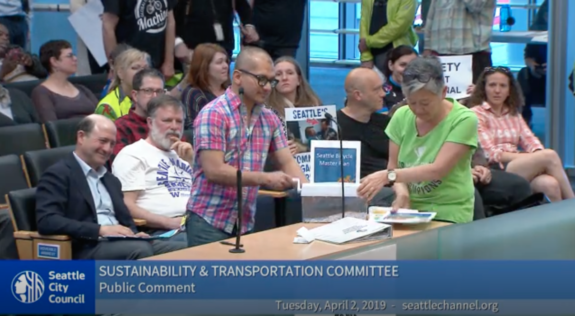

2019 was a red letter year for biking in Seattle. The number of trips people are taking by bike broke through some kind of barrier in the past year, and bike counters across town are clobbering previous records (we’ll have more on that in the new year when the final numbers are in, so stay tuned). So some combination of bike network improvements and bike share and e-bike sales and bike culture have all worked together to make 2019 the bikiest year in Seattle history.
But back in the spring, it hardly felt like this would be a successful biking year for Seattle. Despite signs that the city’s bike investments were working, Mayor Jenny Durkan canceled the 35th Ave NE bike lanes at the last minute even though they were already designed and contracted for construction. She also released a new bike workplan that dramatically scaled back the city’s previous ambitions, especially in the southend. Her decisions triggered a big backlash and a protest at City Hall as people challenged what they saw as her abandoning the city’s Bicycle Master Plan, Climate Action Plan and transportation equity.
This energy flipped the year around. 2019 started with delays and cancellations, but it is ending with record ridership, major bike lane construction and big political momentum. You all did this.
For her first year in office, there was a lot of uncertainty. SDOT went a year without a Director, and projects were getting delayed. In many ways, Mayor Durkan’s springtime anti-bike decisions reignited popular energy in support of the Bike Master Plan, both for the sake of making biking easier and safer and as a way to combat climate change. The city’s biggest transportation advocacy organizations, including Rooted In Rights, Seattle Neighborhood Greenways, Cascade Bicycle Club and the Transit Riders Union had recently joined together as the Move All Seattle Sustainably (“MASS”) coalition. MASS organized a rally at City Hall and ride down 4th Ave to demand that the city build the biking and safety projects in its transportation plans, including key parts of the downtown bike network like 4th Ave.
The City Council passed a bike safety ordinance all but requiring SDOT to build the projects in the Bike Master Plan during repaving projects. If there are serious reasons why they can’t do so, they need to explain themselves to the Council’s Transportation Committee. This doesn’t guarantee that projects won’t be canceled in the future, but no Seattle Mayor should be able to simply cancel a bike lane project on a whim again. It will require explanation to the Council and the people first.
People also organized to support budget additions for funding key south Seattle projects, including the Georgetown to South Park Trail and a north-south bike lane on either Beacon Ave or MLK. The City Council approved these additions in the final budget.
But, of course, state passage of I-976 now hangs over all of this work. If it passes the courts, big and devastating cuts are coming to local, regional and statewide transportation budgets. All of these wins are at risk.
At the state level, Washington Bikes led the way on supporting some ambitious changes to the basic rules of the road governing the care people driving must take when passing someone on a bike. The new rules go beyond many three-foot passing laws in other states and specifically require people to fully change lanes when passing if the road has more than one lane in the direction of travel. This and other rules go into effect January 1.
And despite all this positive news, Lime announced in late December that they will pull their bike share bikes from Seattle streets by the end of the year, rough news for a city that has come to rely on private bike share services like Lime for millions of trips per year.
For more on 2019, Seattle Neighborhood Greenways highlighted the following in a recent blog post:
- Citywide Wins
- Reports from the Neighborhoods – South
- Reports from the Neighborhoods – Central
- Reports from the Neighborhoods – North
What major local bike events do you think defined 2019? Let us know in the comments below.








Comments
3 responses to “Seattle’s bike movement reinvented itself in 2019”
2019 saw ubiquitous dockless bike share. Even if it wasn’t economically sustainable it sure was useful while it lasted.
I wish I could share your optimism.
We have 3 vital needs in SE Seattle:
— SODO – Downtown to Georgetown
— Beacon – Rizal Bridge to Spokane St
— Rainier Valley – I-90 to Columbia City
None of those projects are on the distant horizon.
Pedro, click the link above about SE Seattle bike connections: http://seattlegreenways.org/blog/2019/12/24/2019-year-in-review/#NS2
The connections you mentioned aren’t as far away as it might seem :).